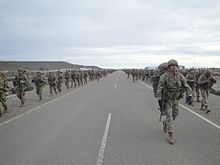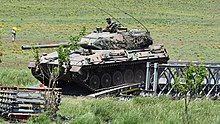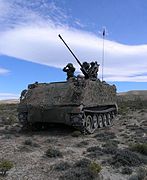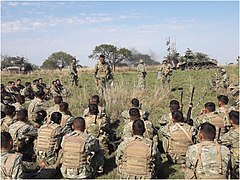Argentine Army
| Argentine Army | ||
|---|---|---|
| Ejército Argentino | ||
 Seal | ||
| Founded | May 29, 1810 | |
| Country | ||
| Branch | Army | |
| Size |
| |
| Part of | Equipment of the Argentine Army | |
| Engagements | List
| |
| Website | argentina.gob.ar/ejercito | |
| Commanders | ||
| Commander-in-chief | President Chief of General Staff Brigadier General Carlos Alberto Presti | |
| Deputy Chief of General Staff | Vacant | |
| Insignia | ||
| Identification symbol |  | |
The Argentine Army (
The Army's official foundation date is May 29, 1810 (celebrated in Argentina as the Army Day), four days after the Spanish colonial administration in Buenos Aires was overthrown. The new national army was formed out of several pre-existing colonial militia units and locally manned regiments; most notably the Infantry Regiment "Patricios", which to this date is still an active unit.
History


Several armed expeditions were sent to the Upper Peru (now

During the civil wars of the first half of the nineteenth century, the Argentine Army became fractionalized under the leadership of the so-called
It was only with the establishment of a constitution (which explicitly forbade the provinces from maintaining military forces of their own) and a national government recognized by all the provinces that the Army became a single force, absorbing the older provincial militias. The Army went on to fight the War of the Triple Alliance in the 1860s together with Brazil and Uruguay against Paraguay. After that war, the Army became involved in Argentina's Conquista del Desierto ("Conquest of the Desert"): the campaign to occupy Patagonia and root out the natives, who conducted looting raids throughout the country.
1880–1960s
Argentine army soldiers with standard uniform in 1938. Between 1880 and 1930, the Army sought to become a professional force without active involvement in politics, even though many a political figure -President
The main foreign influence during this period was, by and large, the

In 1930, a small group of Army forces (not more than 600 troops) deposed President Hipólito Yrigoyen without much response from the rest of the Army and the Navy. This was the beginning of a long history of political intervention by the military. Another coup, in 1943, was responsible for bringing an obscure colonel into the political limelight: Juan Perón.
Even though Perón had the support of the military during his two consecutive terms of office (1946–1952 and 1952–1955), his increasingly repressive government alienated many officers, which finally led to a military uprising which overthrew him in September 1955. Between 1955 and 1973 the Army and the rest of the military became vigilant over the possible re-emergence of Peronism in the political arena, which led to two new coups against elected Presidents in 1962 (deposing
1960s and the military junta
The military government ruled Argentina between 1966 and 1973. During that decade the saw the rise of several terrorist groups including
The new military government, self-named
"Annihilation decrees"

Meanwhile, the
On 5 January 1975, an Army

In response,
The Argentine Army Fifth Brigade, then consisting of the 19th, 20th and 29th Mountain Infantry Regiments
By July 1975, anti-guerrilla commandos were mounting
The leadership of the rural guerrilla force was mostly eradicated and many of the ERP guerrillas and civilian sympathizers in Tucumán were either killed or forcefully disappeared. Efforts to restrain the rural guerrilla activity to Tucumán, however, remained unsuccessful despite the use of 24 recently arrived US-made Bell
In the aftermath, twelve soldiers and two policemen[12] were killed and several wounded. The sophistication of the operation, and the getaway cars and safehouses they used to escape from the crash-landing site, suggest several hundred guerrillas and their supporters were involved.[13] The Argentine security forces admitted to 43 army troops killed in action in Tucuman, although this figure does not take into account police and Gendarmerie troops, and the soldiers who died defending their barracks in Formosa province on 5 October 1975. By December 1975, the Argentine military could, with some justification claim that it was winning the 'Dirty War', but it was dismayed to find no evidence of overall victory.
On 23 December 1975, several hundred ERP fighters[14] with the help of hundreds of underground supporters, staged an all-out battle with the 601st Arsenal Battalion nine miles (14 km) from Buenos Aires and occupied four local police stations and a regimental headquarters.[15] 63 guerrillas,[16] seven army troops and three policemen were killed.[17] In addition 20 civilians were killed in the crossfire. Many of the civilian deaths occurred when the guerrillas and supporting militants burned 15 city buses[18] near the arsenal to hamper military reinforcements. This development was to have far-reaching ramifications. On 30 December 1975, urban guerrillas exploded a bomb inside the Army's headquarters in Buenos Aires, injuring at least six soldiers.[19]
The Montoneros movement successfully utilized divers in underwater infiltrations and blew the pier where the Argentine destroyer
French cooperation
French journalist Marie-Monique Robin has found in the archives of the Quai d'Orsay, the French Minister of Foreign Affairs, the original document proving that a 1959 agreement between Paris and Buenos Aires instaured a "permanent French military mission," formed of veterans who had fought in the Algerian War, and which was located in the offices of the chief of staff of the Argentine Army. She showed how Valéry Giscard d'Estaing's government secretly collaborated with Jorge Rafael Videla's junta in Argentina and with Augusto Pinochet's regime in Chile.[20]
Green deputies
When Minister of Foreign Affairs Dominique de Villepin traveled to Chile in February 2004, he claimed that no cooperation between France and the military regimes had occurred.[24]
Falklands war
The Argentine Army suffered 194 men killed and 1,308 wounded and lost much equipment.[27] The war left the army weakened in equipment, personal, moral and supremacy in the region. The Dirty War events, coupled with the defeat in the Falklands War, precipitated the fall of the military junta that ruled the country, then enters the General Reynaldo Bignone, who began the process of return to democracy in 1983.
1980s to present

Since the return to civilian rule in 1983, the Argentine military have been reduced both in number and budget and, by law, cannot intervene anymore in internal civil conflicts. They became more professional, especially after conscription was abolished.
In 1998, Argentina was granted Major non-NATO ally status by the United States. The modern Argentine Army is fully committed to international peacekeeping under United Nations mandates, humanitarian aid and emergencies relief.
In 2010, the Army incorporated Chinese Norinco armored wheeled APCs to deploy with its peacekeeping forces.[28]
In 2016 President Mauricio Macri modified a decree made by the 1984 government of Raúl Alfonsín which had removed much of the military's autonomy.[29]
A major problem of today's Army is that most of its combat units are understrength in manpower due to budgetary limitations; the current Table of Organization and Equipment being established at a time during which the Army could rely on larger budgets and conscripted troops.[30] Current plans call for the expansion of all combat units until all combat units are again full-strength, as soon as budget constraints allow for the induction of new volunteer service personnel of both genders.
Structure
Army General Staff


The Army is headed by a Chief of General Staff directly appointed by the President. The current Chief of the General Staff (since September 2008) is General Luis Alberto Pozzi.[31] The General Staff of the Army (Estado Mayor General del Ejército) includes the Chief of Staff, a Deputy Chief of the General Staff and the heads of the General Staff's six departments (Jefaturas). The current departments of the General Staff (known also by their Roman numerals) are:
There are also a number of Commands and Directorates responsible for development and implementation of policies within the Army regarding technological and operational areas. They also handle administrative affairs. As of 2020, these include the following:
- Communications and Computer Directorate (Dirección General de Comunicaciones e Informática)
- Education Directorate (Dirección General de Educación)
- Engineers and Infrastructure Directorate (Dirección de Ingenieros e Infraestructura)
- Remount and Veterinary Directorate (Dirección de Remonta y Veterinaria)
- Health Directorate (Dirección General de Salud)
- Personnel and Welfare Directorate
- Materiel Directorate (Dirección General de Material)
- Intelligence Directorate
- Organization and Doctrine Directorate
- Research and Development Directorate (Dirección General de Investigación y Desarrollo)
- Planning Directorate (Dirección de Planeamiento)
- Finance Directorate
- Historical Service Directorate
Field organization

In the 1960s, the Army was reorganised into five Army Corps. This structure replaced the old structure based on divisions following the French model. There was a further reorganisation in 1991, when brigades were assigned to six new divisions, two stationed at Santa Cruz and Mendoza.[32]
Until late 2010, the First, Second and Third Army Divisions were designated as the Second, Third and Fifth Army Corps (Cuerpos de Ejército) respectively, without any intermediate division-level commands. These redesignations took place as part of a major reorganization of the Armed Forces' administrative and command structure. Two additional Army Corps, the First and Fourth, had already been dissolved in 1984 and 1991 respectively, with their dependent units reassigned to the remaining three Army Corps.
As of 2011, army forces are geographically grouped into three Army Divisions (Divisiones de Ejército), each roughly equivalent in terms of nominal organization to a U.S. Army division (+). Each Army Division has an area of responsibility over a specific region of the country; First Army Division covers the northeast of the country, Second Army Division covers the center and northwest of Argentina and Third Army Division covers the south and Patagonia. In addition to the three Army Divisions, the Rapid Deployment Force (Fuerza de Despliegue Rápido, FDR) forms an additional fourth divisional-level formation, while the Buenos Aires Military Garrison operates independently from any division-sized command. There are also several separate groups, including an anti-aircraft group and the Argentine Army Aviation group.
Each division has varying numbers of brigades of armor, mechanized forces and infantry.
As of 2011, the Argentine Army has eleven brigades:
- two armored brigades (1st and 2nd),
- three mechanized brigades (9th, 10th and 11th),
- three mountain brigades (5th, 8th),
- one paratrooper brigade (4th) and
- two bush brigades (3rd and 12th).
Note: The 7th Infantry Brigade was dissolved in early 1985, while the 3rd Infantry Brigade was converted into a motorized training formation, which was ultimately dissolved in 2003.

Depending on its type, each brigade includes two to five Cavalry or Infantry Regiments, one or two Artillery Groups, a scout cavalry squadron, one battalion or company-sized engineer unit, one intelligence company, one communications company, one command company and a battalion-sized logistical support unit. The terms "regiment" and "group", found in the official designations of cavalry, infantry and artillery units, are used due to historical reasons. During the Argentine War of Independence, the Argentine Army fielded traditional regiment-sized units. 'Regiments' are more accurately described as battalions; similar-sized units that do not belong to the above-mentioned services are referred to as "battalions". In addition to their service, Regiments and Groups are also specialized according to their area of operations (Mountain Infantry, Jungle Infantry, Mountain Cavalry), their equipment (Tank Cavalry, Light Cavalry, Mechanized Infantry) or their special training (Paratroopers, Commandos, Air Assault, Mountain Cazadores or Jungle Cazadores). Regiments are made up by four maneuver sub-units (companies in infantry regiments and squadrons in cavalry regiments) and one command and support sub-unit for a total of 350 to 700 troops.
In 2006, a
In 2008, a
Equipment
Ranks
Insignia for all ranks except volunteers is worn on shoulder boards. Ranks from colonel major onwards use red-trimmed shoulderboards and the suns denoting rank are gold-braid; the suns on other officers' shoulder boards are metallic. Generals also wear golden wreath leaves on their coat lapels.
The rank insignia for volunteers 1st class, 2nd class and commissioned 2nd class is worn on the sleeves. Collar versions of the ranks are used in combat uniforms.
The highest army rank in use is lieutenant-general. A higher army rank, captain-general, was awarded twice in the nineteenth century: to José de San Martín and to Bernardino Rivadavia. As a promotion to this rank is not foreseen, no insignia for the rank currently exists.
Officers
| Rank group | General / flag officers | Senior officers | Junior officers | Officer cadet | ||||||||||||||||||||||||||||||||
|---|---|---|---|---|---|---|---|---|---|---|---|---|---|---|---|---|---|---|---|---|---|---|---|---|---|---|---|---|---|---|---|---|---|---|---|---|

|

|

|

|

|

|

|

|

|

|

|
||||||||||||||||||||||||||
| Teniente general | General de división | General de brigada | Coronel mayor | Coronel | Teniente coronel | Mayor | Capitán | Teniente primero | Teniente | Subteniente | ||||||||||||||||||||||||||
The rank of coronel mayor (senior colonel) is an honorary distinction for colonels occupying general's positions (such as brigade commander), but who are not senior enough to be promoted.[34]
NCOs and enlisted
| Rank group | Senior NCOs | Junior NCOs | Enlisted | |||||||||||||||||||||||||||||||||
|---|---|---|---|---|---|---|---|---|---|---|---|---|---|---|---|---|---|---|---|---|---|---|---|---|---|---|---|---|---|---|---|---|---|---|---|---|

|

|

|

|

|

|

|

|

|

| |||||||||||||||||||||||||||
| Suboficial mayor | Suboficial principal | Sargento ayudante | Sargento primero | Sargento | Cabo primero | Cabo | Voluntario primero | Voluntario segundo | Soldado de segunda en comisión | |||||||||||||||||||||||||||
Image gallery
-
"Air cavalry" of the Argentine Army.
-
Two TAM VCA in exercise.
-
Medium Argentine Tank.
-
Self-propelled mortar VCTM opening fire.
-
ArgentineM-113equipped with AA cannon.
-
Unimog truck of the Argentine Army.
-
Argentine Army Exploration Squadron.
-
Argentine Infantry.
-
Argentine soldiers on surveillance at the border.
-
Argentine soldiers receiving instructions before exercise.
-
communications platoon of the Argentine army.
-
Argentine hunter infantry.
-
REO M35 truck
-
Bell UH-1 Huey of the Argentine Army
-
Armored infantry in M-113s
See also
- Argentine Naval Aviation
- Argentine Army Aviation
- Equipment of the Argentine Army
References
Citations
- ^ Hugo Moreno, Le désastre argentin. Péronisme, politique et violence sociale (1930–2001), Editions Syllepses, Paris, 2005, p.109 (in French)
- ^ "Buenos Aires News – Argentina reveals secrets of 'dirty war'". Archived from the original on 14 May 2013. Retrieved 24 December 2014.
- ^ Paul H. Lewis, Guerrillas & Generals: The "Dirty War" in Argentina, Praeger Paperback, 2001, p. 126.
- ^ John Keegan, World Armies|page=22, Macmillan, 1983
- ^ TUCUMAN 1975: Avión del Ejército Argentino es derribado con ametralladoras antiaéreas Archived 2011-07-06 at the Wayback Machine
- ^ "[E]l commando general del Ejército procederá a ejecutar todas las operaciones militares que sean necesarias a efectos de neutralizar o aniquilar el accionar de los elementos subversivos que actúan en la provincia de Tucumán" (in Spanish)
- ^ Decree No. 261/75 Archived 2006-11-15 at the Wayback Machine. NuncaMas.org, Decretos de aniquilamiento.
- ^ Facts on File, p. 126 (1975)
- ^ English, Adrian J. Armed Forces of Latin America: Their Histories, Development, Present Strength, and Military Potential, Janes Information Group, 1984, p. 33
- ISSN 0362-4331. Retrieved 2023-05-13.
- ISBN 978-0-271-01015-1.
- ^ "The Montreal Gazette – Google News Archive Search". Retrieved 24 December 2014.
- ^ "The Sydney Morning Herald – Google News Archive Search". Retrieved 24 December 2014.
- ^ "monte chingolo guerrillas and generals – Google Search". Retrieved 24 December 2014.
- ^ Troops fight off guerrillas, The Rock Hill Herald, 22 December 1975
- ^ Monte Chingolo: Voces de Resistencia Archived 2009-11-30 at the Wayback Machine
- ^ "Argentina: Hanging from the Cliff". Time. 5 January 1976.
- ^ "The Windsor Star – Google News Archive Search". Retrieved 24 December 2014.
- ^ "Argentine theatre hit by bomb" The Spokesman-Review 31 December 1975
- ^ Conclusion of Marie-Monique Robin's Escadrons de la mort, l'école française (in French)
- ^ MM. Giscard d'Estaing et Messmer pourraient être entendus sur l'aide aux dictatures sud-américaines, Le Monde, September 25, 2003 (in French)
- ^ « Série B. Amérique 1952–1963. Sous-série : Argentine, n° 74. Cotes : 18.6.1. mars 52-août 63 ».
- French National Assembly(in French)
- ^ Argentine : M. de Villepin défend les firmes françaises, Le Monde, February 5, 2003 (in French)
- ^ "Falkland Islands War | Summary, Casualties, Facts, & Map | Britannica". www.britannica.com. Retrieved 2023-05-13.
- ^ "Operación Rosario". Argentina.gob.ar. Argentine Ministry of Defence. 7 May 2018. Retrieved 8 June 2018.
- ^ "1.657 heridos 1.308 del Ejército 303 de la Armada 46 de la Fuerza Aérea." Historia Marítima Argentina, p. 137, Argentina. Departamento de Estudios Históricos Navales Cuántica Editora, 1993
- ^ vehículos Norinco de reciente provisión
- ^ Rivas Molina, Federico (June 3, 2016). "Mauricio Macri reduce el control civil sobre las Fuerzas Armadas". El País (in Spanish). Retrieved August 30, 2017.
- ^ "Argentina Military Spending/Defense Budget 1960-2023". www.macrotrends.net. Retrieved 2023-05-13.
- ^ Nueva, La. "La Nueva". www.lanueva.com (in Spanish). Retrieved 2019-03-09.
- ^ Jane's Defence Weekly 2 February 1991
- ^ a b "Grados". argentina.gob.ar (in Spanish). Government of Argentina. Retrieved 27 May 2021.
- ^ "Coronel Mayor y Comodoro de Marina" (PDF). Archived from the original (PDF) on 2016-09-10. Retrieved 2013-06-08.
Sources
- ISBN 978-1-85743-557-3.
Further reading
- Garcia Loperena, Gaston Javier (August 2016). El Unimog en el Ejercito Argentino (in Spanish) (1st ed.). 1884 Editorial – Buenos Aires (2015). ISBN 9789509822993. Archived from the originalon 2017-01-22. Retrieved 2016-10-27.
- Garcia Loperena, Gaston Javier (March 2015). Vehiculos Tacticos del Ejercito Argentino (in Spanish) (1st ed.). 1884 Editorial – Buenos Aires (2014). ISBN 9789509822962. Archived from the originalon 2017-01-22. Retrieved 2016-10-27.
External links
- Official website
 (in Spanish)
(in Spanish) - Organization and equipment on Saorbats.com
- Globalsecurity.org – Argentine Army – Equipment (page updated 05-02-2015) (accessed 2015-02-28)















